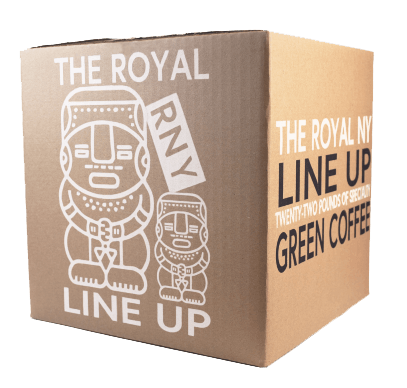No products in the cart.
Coffee
How to Use the SCA Cupping Form

Purpose and Overview of the SCA Form:
The SCA Cupping Form is the Global Standard for cupping coffee. That doesn’t mean that it’s the only form used for cupping coffee. If you have ever heard of coffeereview.com or Cup of Excellence, they both use other forms for scoring. Even at Royal NY we use a slightly modified SCA Cupping Form to better suit our needs, but more on that later!
So, what is this form and why does it exist? This form is a standardized language in which to communicate along the whole coffee supply stream about quality and therefor value. The form uses the universal language of numbers, so as to make it a clearer communication tool than just words would allow. For example, if you ask Ethiopian coffee farmers what their natural coffee should taste like, the majority of them would respond ‘blueberries’ and if you asked the same group what a blueberry tastes like, or if they have ever had one, the majority would say no (analogy courteous of Jodi Weiser of Gather Coffee.) If one is paying for green coffee solely based on preference or the tasting note ‘blueberry’ it would make it a hard metric for a producer to use, and not a very fair one at that. The SCA form takes preference and specifics out of the equation and leaves only qualitative data. The other thing the form does is draw a clear line at 80 points to define whether a coffee is or isn’t ‘specialty.’ The term, ‘Specialty Coffee‘ was first coined by Erna Knutsen in the 1974 issue of Tea and Coffee Trade Journal to describe coffees with the best flavors produced in specialty micro climates. Although, we now know it takes a lot more than that to produce specialty coffee! The form which uses a numerical system to quantify what makes a coffee specialty, came years later, in the late 1990’s – although cupping had already been going on for about a century.
Almost anyone can be calibrated to use this form. It does take a good amount of training to come into calibration (score similarly to others using the form). We suggest taking RNY’s Advanced Cupping Course or Coffee Grading Course to start out. You could also take CQI’s Cupping Essentials or CQI’s Q-Grader Course and Exam. Taster’s that have achieved the Q Grader Certificate are calibrated with other Q-Graders at a global level, in other words, any two Q-Graders should assign a given coffee a very similar, if not the same, grade. But don’t fret if you are not ready for that step yet. The first step is understanding the SCA Grading System and we are here to help! We also want to clarify, this form is built for grading the intrinsic quality of a given coffee, as opposed to comparing roast profiles, or coming up with information to convey to customers.
Using the Form:
The SCA form is actually a pretty narrow window, as is ‘specialty coffee’ in general (10% of the overall arabica industry.) Even though the scale is technically 0-100, often you are only working in the 80-95 point range. If a coffee is below 80, often it is not scored because it is not considered specialty and should not be graded with the ‘specialty’ system. Coffees above 95 points are EXTREMELY rare. We are also only working in a 6-10 range for scoring. Why not 5 you ask? Well, 6 is considered ‘good’ and in other words, if a coffee is less than good in any of the categories the coffee should not be considered specialty.
Figuring out a baseline for scoring different attributes like acidity and body in coffee can be a bit tricky. It takes tasting a large variety of coffees, tasting often, and using the form consistently. Some things to keep in mind are that if every measurable category for a coffee is scored a 7 and there were no defects, the final score is 79. On the other hand, if every measurable category for a coffee is scored an 8, the final score is 86. To score a coffee effectively, you must train yourself to be objective and unbiased.

For setting up a cupping in which you will be using the SCA form, we suggest using this format, with 5 cups of each coffee placed next to each other in an ‘M’ shaped format. More information on appropriate protocols for SCA Cupping, can be found here. One other suggestion we have is to use a pencil to fill out the form. As your experience changes, reevaluate each coffee and make edits to your notes and score if needed. Using a pencil can make this much easier and your form will appear cleaner. Write any notes that correlate to a given category directly under that category in the notes section.
Let’s begin with the form dissection… First things first, always fill out your whole form, including sample numbers (or coffee names.) There is so much going on when we are tasting it is important that we don’t get coffees mixed up on the form.
Roast Level, Fragrance and Aroma:
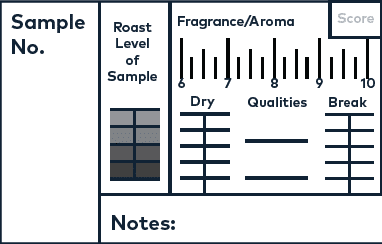
So now that you have filled out all the boring details, it’s time to start evaluating. First, check all the samples for roast level. If they are of the same level and that level is appropriate for grading, mark the middle of the vertical scale. More on appropriate sample preparation can be found here.
Now that that’s out of the way, it it time to check the ‘dry fragrance.’ The vertical scales on the form are always to mark intensity. So put a quick dash as to how intense the smell is, write the primary attribute on the top line in the box and any additional notes below the box. As far as the actual score goes, maybe make a dot above what the dry fragrance implies. The final score given should reflect the preference of all three aspects (dry, wet and break) of a sample’s Fragrance/Aroma.
The same process should be repeated with the wet aroma/break and the 2nd horizontal line in the box and vertical scale to the right. Coffees free of off-putting aromas, with a variety of different notes with higher intensity levels are scored highest. For instance, if we cupped a coffee that just smelled like chocolate and nuts with medium intensity it would probably receive a 7.25-7.5. On the other hand a coffee with notes of berries, florals and spice with a high intensity would be up in the 8.5+ land.
Flavor & Aftertaste:
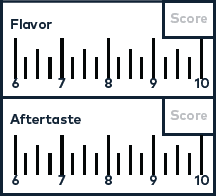
Flavor represents the coffee’s principal character from beginning to end. This is the result of your entire flavor experience, including gustatory sensations or taste and retro-nasal aromas. A helpful way to look at it is: the more ‘tasting notes’ you can come up with, coupled with a variety of flavors would result in a high score (i.e. if your notes are: peach, nectarine, stone-fruit that would not be considered a variety of flavors.)
Aftertaste is defined by the length of positive flavor qualities emanating from the back of the palate and remaining after the coffee has been swallowed or disposed of. An aftertaste that lingers on and is pleasant would be the most rewarded on the scoresheet.
Acidity:
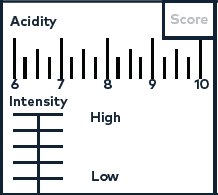
A pleasant acidity would be considered bright as opposed to sour. This often eludes to how much sweetness is in a given coffee. If there is intense citric acid, but no sweetness, the cup would just be unpleasant. On the other hand a good amount of complex acidity with sweetness to match, leads to the perception of a lot of the ‘fruity’ flavors in a coffee and should be highly rewarded. The final score marked on the horizontal scale should reflect primarily the quality of the acidity (think lemonade versus lemons) the variety of organic acids (citric, malic, ascetic, phosphoric, quinic, tartaric, etc) as well as the intensity of the acidity. Something to also take into consideration here is the origin the coffee and processing method. An African coffee would be rewarded a little less for high acidity, then lets say a Brazilian coffee with the same acidity. This is because we EXPECT an African coffee to be higher in acidity than a South or Central American Coffee, especially a Brazil. These ‘expectations’ for different coffee origins or processing methods are defined by tasting lots of coffee overtime.
Body:
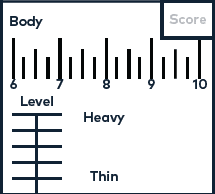
The body score for a coffee is the result of the heaviness in the mouthfeel of a coffee, as well as the quality of the tactile sensation. For instance, a heavy but ‘silty’ tactile sensation would be a middle of the road score or maybe even lower, as opposed to a viscous full mouthfeel. Once again, origin and processing method expectations should be taken into consideration. i.e. A naturally processed coffee with a thinner or tea-like body would receive a lower score than a Washed Process Coffee with a similar body, because the expectation of natural coffees are that they generally have rounder heavier bodies.
Balance:
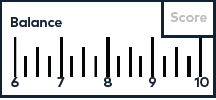
Balance is considered a culmination of all of the previous categories. Ask yourself how does the body correlate to the acidity and flavor? Does the coffee just ‘work?’ Is it like a smooth symphony or an erratic noise band, with pleasant attributes but no cohesiveness? Higher scores here would be a result of a complex coffee that is very cohesive, where all attributes are working well together. Imagine a high end, complex washed Ethiopian Yirgacheffe for instance… Most likely, it would have a lower score (7.25 – 7.5) for it’s tea-like body, a middle of the road score for it’s pleasant mild malic and citric acidity (7.5-7.75) and a high score for it’s complex pleasant flavor (7.75 – 8.5.) The score for balance for this imaginary coffee, would most likely be high (7.75-8.5.) All the attributes are pleasant and work well together. Although the body score was a bit low, the tea-like body works great for this coffee. This is the section you would reward that. Keep in mind this is all just for a ‘hypothetical coffee.’ A Yirgacheffe could score anything from below specialty to the high 90’s….
Uniformity, Clean Cup & Sweetness:
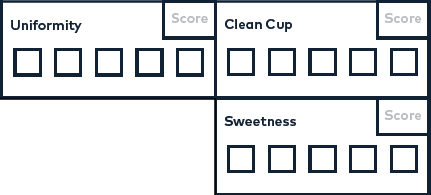
The Waterfall Effect: Uniformity, Clean Cup & Sweetness
Uniformity: Do all the cups taste the same? It’s as simple as that. If any cup is different, that cup is marked on the sheet and 2 points are reduced from the total scoring potential of 10 points. If a box is checked move on to ‘Clean Cup.’ If nothing is checked, the coffee receives a 10 for this category. Clean Cup and Sweetness would also be given scores of 10. One thing to also mention here is that the boxes correspond to the cup order. The 5 cups in the ‘M’ formation’ are numbered in correlating order (far bottom left=cup 1, top left=cup 2, bottom middle = cup 3, and so on.)
Clean Cup: Is the ‘non-uniform’ cup identifiable as having a known defect? In other words can you identify the defect? Phenol, Ferment, Mold, Potato or Sour? If the answer is yes, then the appropriate box is checked, the defect is identified under the section (under “notes”) and 2 points are subtracted from the potential 10 points, leaving it with a score of 8 for Clean Cup.
Sweetness: Has the known defect rendered this cup unpalatable? For this box to be checked, the coffee must have an intense ‘fault level’ defect (more on this later.) Is there any sweetness left? If no, mark the appropriate box referring to the defective cup (the same box as uniformity and clean cup) as well as subtract 2 from the potential 10 points. To be clear here, this category has nothing to do with the overall sweetness of the coffee. It only represents whether a specific cup in the set, has zero sweetness due to the defect identified in it.
Overall:
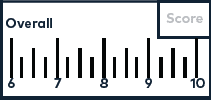
Overall: This is the only section on this form where your opinion matters! If you thought this coffee was really good, but did not find specific sections to reward it, this is where you would. The opposite is true as well. The score should reflect the previous categories though.
Final Scoring:
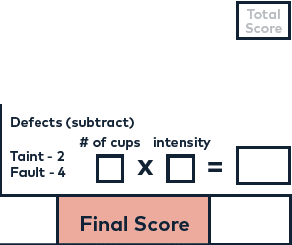
Defects: Defects are negative or poor flavors that take away from the cup. They can be an issue with just one bean in one cup or multiple beans. If a coffee is harvested with care and processed well the coffee should not have any defects. Identifying any defect for a given coffee will most likely will knock the coffee out of the specialty level. So, be sure when marking them off. If you have checked any boxes in the ‘Clean Cup’ category, you would also need to subtract points here for the defect.
A taint is an off-flavor/defect that is noticeable and identifiable but does not render a cup unpalatable. A “taint” is given a “2” for intensity.
A fault is an off-flavor/defect that is overwhelming and renders a coffee unpalatable. It is then given an intensity rating of “4”.
So what do you do if there is more than 1 defect for a given coffee? or one cup is ‘fault’ level and another is ‘taint level.’ Honestly, there are a few different schools of thought on this one. Either you can do the math, and subtract 6 from the total score and note why, or you can choose the fault level defect and multiple by the number of cups. At this point when dealing with a coffee that has multiple defective cups, there is no way it can be classified as specialty, so it really doesn’t matter very much which method you choose.
Once you have all of your numbers entered in the little boxes to the upper right of each category. You first total all of the scores and enter that number under ‘total score.’ If there is a defective cup, then you subtract for the fault or taint level defect, if there is no defect then you can write ‘0’ in those boxes and total your final score up and enter it in the bottom right box.
In other words, if you find one cup in the set that is taint level phenolic, you would have dinged the coffee under ‘Uniformity,’ leaving it with a score of 8 for that category. You would have also dinged it under ‘Clean Cup,’ leaving it with s score of 8 for that category as well. The ‘Sweetness score’ would still be ’10.’ Once you total all of the categories, let’s say the coffee was an 82. You would then subtract an additional 2 points (1 cup x 2 points for a taint level defect,) leaving it with a score of 80. How sad is that? This coffee would have been an 86 point coffee if no defect was found.
A few last notes about using this form… 1) If you identify a defect, make sure to only grade the cups without the defect. This allows for the person seeing the form to know what the score would have been if the defect had been avoided. Often, we have to avoid tasting that defective cup on our subsequent passes, so that it doesn’t taint our opinion. 2) Make sure to ‘Reward’ and ‘Penalize’ a coffee in only one category for a given attribute. For instance, if you think the aftertaste is ‘drying,’ maybe only penalize it in the ‘Aftertaste’ category as opposed to both ‘Body’ and ‘Aftertaste.’ Although the negative attribute is tactile related, it is important to judge the whole tactile experience and not just the end of it. As well as avoid subtracting multiple points in multiple areas for one characteristic.
______
Congrats! You have now scored coffee using the SCA cupping form! Next step is to continue to use this form so that you can get a clearer perspective on different quality aspects of different coffees, as well as communicate clearer about them!
______
At Royal NY, we have modified the SCA cupping form to incorporate a score for quality and intensity of sweetness. We also have removed balance, as well as any sections referring to defects. If a coffee doesn’t meet a given spec for that coffee, we recup or reject the entire lot (of course with a good explanation of the problem to the seller), so there is really is no reason for us to incorporate defects into our score. Often, our scores using this form are very close to those of the SCA form, and if anything a touch more conservative.

